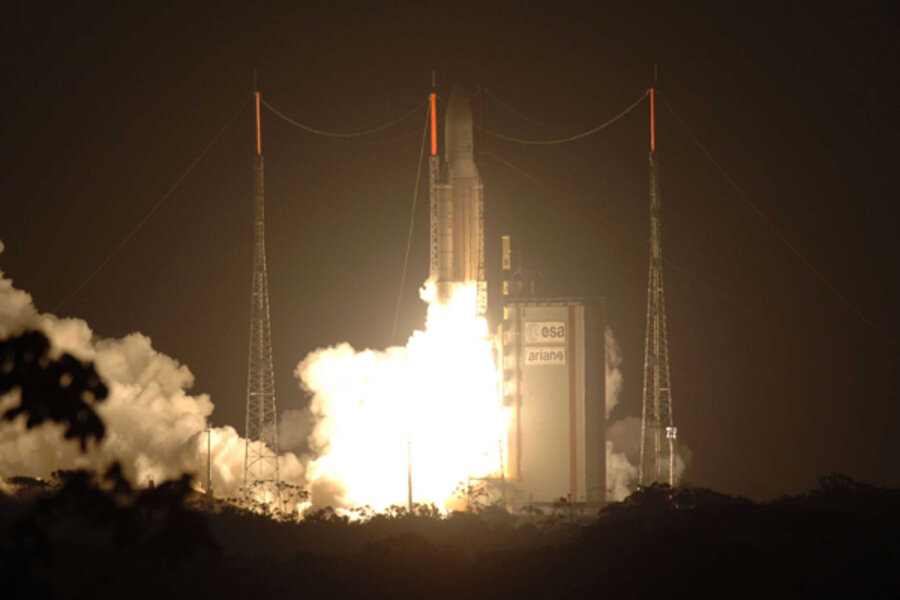Zombie satellite still careening through space
Loading...
The so-called Galaxy 15 zombie satellite that lost contact with ground controllers on Earth in April is still adrift in space, with engineers keeping a close eye on the wayward satellite as it approaches two other spacecraft this month.
The Galaxy 15 satellite is currently drifting along a stable and predictable path, according to its communications satellite fleet operator Intelsat. The main focus now is preventing Galaxy 15 from interfering with other nearby satellites, including two of Intelsat's own, though no collisions are expected.
"The overall goal is to minimize disruption," Steve Good, Intelsat's global director of customer solutions engineering, told SPACE.com. "It's in all of our best interests to minimize any disruption."
IN PICTURES: In orbit
The company is preparing several techniques to mitigate potential signal interference as Galaxy 15 is set to fly by two other Intelsat satellites this month: Galaxy 13 and Galaxy 14.
The 4,171-pound (1,892-kg) Galaxy 15 satellite went rogue on April 5, when it stopped responding to controllers on the ground.
Yet, while the satellite veered from its assigned orbital slot of 133 degrees west longitude, 36,000 kilometers over the equator, the "zombie satellite" maintained an active payload, with its C-band telecommunications still functioning.
Interference from Galaxy 15's stuck-on signal is the main concern, since the chance of it actually crashing into other satellites is remote to non-existent, Intelsat officials have said.
Not quite in the clear
On Thursday, July 8, Galaxy 15 is expected to begin approaching Galaxy 13, making its closest pass on July 13.
"Galaxy 15 has a very large inclination, and if it stayed there, that would be great," Good said, referring to the tilt of the satellite's orbit with respect to Earth's equator. "But, twice a day it crosses the zero longitude line. At that point in time, that's when the physical distance between the two satellites is going to be minimized."
Intelsat's Galaxy 13 and Galaxy 14 satellites both provide video media services to U.S. customers, and the satellite operator has been in regular contact with users in preparation for the flybys.
"We're looking at each customer specifically," Good said. "We're working with them and we've offered them options. We've been in talks almost daily."
Galaxy 15 will begin entering Galaxy 14's orbit on July 26. It will make its closest pass on July 30.
Avoiding interference
Intelsat engineers have planned a variety of techniques to address interference concerns from Galaxy 15, including boosting the sensitivity of satellites the zombiesat flies near, and moving them if necessary. They are also arranging for some customers who uplink to Galaxy 13 or 14 services to shift – or "mispoint" – their antennas, depending on the location of the rogue satellite, so they don't receive its wayward signals.
"If you have a large antenna, for example, you can mispoint to the east, and as soon as Galaxy 15 passes, you then mispoint to the west," Good explained. "It's like you're intentionally avoiding the Galaxy 15 satellite."
In addition, while each case is different, Good and his team can look to their successful collaboration with SES as inspiration.
In May, the satellite operator SES World Skies, whose AMC-11 satellite orbited into Galaxy 15's cross-hairs, worked with Intelsat to successfully perform a series of intricate maneuvers in order to avoid interference and service interruptions.
"Not all flybys are created equal, but we certainly learned a lot of lessons from the first one," he said.
Intelsat will also be able to use this knowledge to tackle similar circumstances in the future.
The company will next work closely with Telesat, a satellite services provider headquartered in Ottawa, Canada, since Galaxy 15 is expected to swoop near Telesat's Anik F3 satellite, following the Galaxy 13 and 14 encounters.
A mind of its own
Several attempts to shut down Galaxy 15 have been unsuccessful, leaving the defunct satellite drifting in the cosmos.
"Normally when an anomaly occurs, the satellite just stops working and we don't have to worry about it," Good said. "Galaxy 15 is still operational, so in this case, the satellite is still "functioning" in a deterministic state. But, we know exactly where it is, we know what it's doing, and we know the settings of the satellite."
Galaxy 15 launched on Oct. 13, 2005 aboard an Ariane rocket. Its manufacturer, Orbital Sciences Corp. of Virginia, has said that an intense solar storm in early April may have caused the breakdown in communication.
Meanwhile, Intelsat has launched an on-going technical investigation, but has yet to reach any definitive conclusions as to the cause of the glitch.
Such an anomaly, however, is unprecedented, said Good.
"This is definitely a unique situation," he said. "There are people who have worked here for over 40 years who have not seen such a thing."
The future of zombiesat
Eventually, Galaxy 15 is expected to lose its Earth-pointing capability. Once this lock on Earth is lost and its solar panels are no longer pointed at the sun, the satellite's battery power will eventually die.
"When the battery power decreases past a certain threshold, the payload will shut off," Good explained. "It will no longer receive and transmit, and its batteries will continue to deplete."
The satellite could also reach a threshold that causes its onboard computers to reset, said Good, but the possibility of this happening is still unknown.
"There is a possibility that the onboard computer could reset, but we don't know what that probability is," he said. "Still, there is a chance. It would almost be like a "control-alt-delete" on your computer. It would begin sending telemetry again. It would wake up and realize 'What am I doing here?'"
- Worst Space Debris Moments in History
- Images - Spotting Satellites and Spaceships From Earth
- Life's Little Mysteries: How Much Junk is in Space?
IN PICTURES: In orbit





